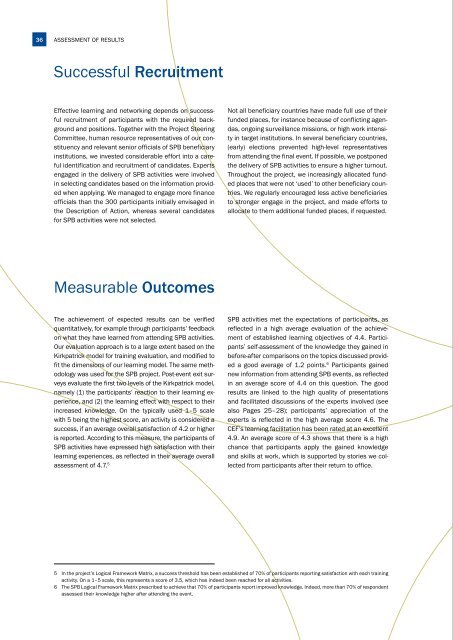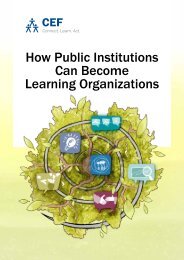Final Report: Strategic Planning and Budgeting
Effective Multi-Beneficiary Learning and Networking
Effective Multi-Beneficiary Learning and Networking
Create successful ePaper yourself
Turn your PDF publications into a flip-book with our unique Google optimized e-Paper software.
36<br />
ASSESSMENT OF RESULTS<br />
Successful Recruitment<br />
Effective learning <strong>and</strong> networking depends on successful<br />
recruitment of participants with the required background<br />
<strong>and</strong> positions. Together with the Project Steering<br />
Committee, human resource representatives of our constituency<br />
<strong>and</strong> relevant senior officials of SPB beneficiary<br />
institutions, we invested considerable effort into a careful<br />
identification <strong>and</strong> recruitment of c<strong>and</strong>idates. Experts<br />
engaged in the delivery of SPB activities were involved<br />
in selecting c<strong>and</strong>idates based on the information provided<br />
when applying. We managed to engage more finance<br />
officials than the 300 participants initially envisaged in<br />
the Description of Action, whereas several c<strong>and</strong>idates<br />
for SPB activities were not selected.<br />
Not all beneficiary countries have made full use of their<br />
funded places, for instance because of conflicting agendas,<br />
ongoing surveillance missions, or high work intensity<br />
in target institutions. In several beneficiary countries,<br />
(early) elections prevented high-level representatives<br />
from attending the final event. If possible, we postponed<br />
the delivery of SPB activities to ensure a higher turnout.<br />
Throughout the project, we increasingly allocated funded<br />
places that were not ‘used’ to other beneficiary countries.<br />
We regularly encouraged less active beneficiaries<br />
to stronger engage in the project, <strong>and</strong> made efforts to<br />
allocate to them additional funded places, if requested.<br />
Measurable Outcomes<br />
The achievement of expected results can be verified<br />
quantitatively, for example through participants’ feedback<br />
on what they have learned from attending SPB activities.<br />
Our evaluation approach is to a large extent based on the<br />
Kirkpatrick model for training evaluation, <strong>and</strong> modified to<br />
fit the dimensions of our learning model. The same methodology<br />
was used for the SPB project. Post-event exit surveys<br />
evaluate the first two levels of the Kirkpatrick model,<br />
namely (1) the participants’ reaction to their learning experience,<br />
<strong>and</strong> (2) the learning effect with respect to their<br />
increased knowledge. On the typically used 1–5 scale<br />
with 5 being the highest score, an activity is considered a<br />
success, if an average overall satisfaction of 4.2 or higher<br />
is reported. According to this measure, the participants of<br />
SPB activities have expressed high satisfaction with their<br />
learning experiences, as reflected in their average overall<br />
assessment of 4.7. 5<br />
SPB activities met the expectations of participants, as<br />
reflected in a high average evaluation of the achievement<br />
of established learning objectives of 4.4. Participants’<br />
self-assessment of the knowledge they gained in<br />
before-after comparisons on the topics discussed provided<br />
a good average of 1.2 points. 6 Participants gained<br />
new information from attending SPB events, as reflected<br />
in an average score of 4.4 on this question. The good<br />
results are linked to the high quality of presentations<br />
<strong>and</strong> facilitated discussions of the experts involved (see<br />
also Pages 25–28); participants’ appreciation of the<br />
experts is reflected in the high average score 4.6. The<br />
CEF’s learning facilitation has been rated at an excellent<br />
4.9. An average score of 4.3 shows that there is a high<br />
chance that participants apply the gained knowledge<br />
<strong>and</strong> skills at work, which is supported by stories we collected<br />
from participants after their return to office.<br />
5 In the project’s Logical Framework Matrix, a success threshold has been established of 70% of participants reporting satisfaction with each training<br />
activity. On a 1–5 scale, this represents a score of 3.5, which has indeed been reached for all activities.<br />
6 The SPB Logical Framework Matrix prescribed to achieve that 70% of participants report improved knowledge. Indeed, more than 70% of respondent<br />
assessed their knowledge higher after attending the event.

















